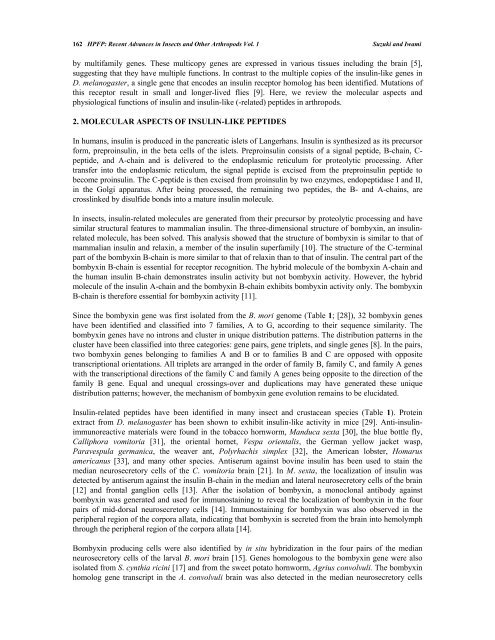chapter 1 - Bentham Science
chapter 1 - Bentham Science
chapter 1 - Bentham Science
You also want an ePaper? Increase the reach of your titles
YUMPU automatically turns print PDFs into web optimized ePapers that Google loves.
162 HPFP: Recent Advances in Insects and Other Arthropods Vol. 1 Suzuki and Iwami<br />
by multifamily genes. These multicopy genes are expressed in various tissues including the brain [5],<br />
suggesting that they have multiple functions. In contrast to the multiple copies of the insulin-like genes in<br />
D. melanogaster, a single gene that encodes an insulin receptor homolog has been identified. Mutations of<br />
this receptor result in small and longer-lived flies [9]. Here, we review the molecular aspects and<br />
physiological functions of insulin and insulin-like (-related) peptides in arthropods.<br />
2. MOLECULAR ASPECTS OF INSULIN-LIKE PEPTIDES<br />
In humans, insulin is produced in the pancreatic islets of Langerhans. Insulin is synthesized as its precursor<br />
form, preproinsulin, in the beta cells of the islets. Preproinsulin consists of a signal peptide, B-chain, Cpeptide,<br />
and A-chain and is delivered to the endoplasmic reticulum for proteolytic processing. After<br />
transfer into the endoplasmic reticulum, the signal peptide is excised from the preproinsulin peptide to<br />
become proinsulin. The C-peptide is then excised from proinsulin by two enzymes, endopeptidase I and II,<br />
in the Golgi apparatus. After being processed, the remaining two peptides, the B- and A-chains, are<br />
crosslinked by disulfide bonds into a mature insulin molecule.<br />
In insects, insulin-related molecules are generated from their precursor by proteolytic processing and have<br />
similar structural features to mammalian insulin. The three-dimensional structure of bombyxin, an insulinrelated<br />
molecule, has been solved. This analysis showed that the structure of bombyxin is similar to that of<br />
mammalian insulin and relaxin, a member of the insulin superfamily [10]. The structure of the C-terminal<br />
part of the bombyxin B-chain is more similar to that of relaxin than to that of insulin. The central part of the<br />
bombyxin B-chain is essential for receptor recognition. The hybrid molecule of the bombyxin A-chain and<br />
the human insulin B-chain demonstrates insulin activity but not bombyxin activity. However, the hybrid<br />
molecule of the insulin A-chain and the bombyxin B-chain exhibits bombyxin activity only. The bombyxin<br />
B-chain is therefore essential for bombyxin activity [11].<br />
Since the bombyxin gene was first isolated from the B. mori genome (Table 1; [28]), 32 bombyxin genes<br />
have been identified and classified into 7 families, A to G, according to their sequence similarity. The<br />
bombyxin genes have no introns and cluster in unique distribution patterns. The distribution patterns in the<br />
cluster have been classified into three categories: gene pairs, gene triplets, and single genes [8]. In the pairs,<br />
two bombyxin genes belonging to families A and B or to families B and C are opposed with opposite<br />
transcriptional orientations. All triplets are arranged in the order of family B, family C, and family A genes<br />
with the transcriptional directions of the family C and family A genes being opposite to the direction of the<br />
family B gene. Equal and unequal crossings-over and duplications may have generated these unique<br />
distribution patterns; however, the mechanism of bombyxin gene evolution remains to be elucidated.<br />
Insulin-related peptides have been identified in many insect and crustacean species (Table 1). Protein<br />
extract from D. melanogaster has been shown to exhibit insulin-like activity in mice [29]. Anti-insulinimmunoreactive<br />
materials were found in the tobacco hornworm, Manduca sexta [30], the blue bottle fly,<br />
Calliphora vomitoria [31], the oriental hornet, Vespa orientalis, the German yellow jacket wasp,<br />
Paravespula germanica, the weaver ant, Polyrhachis simplex [32], the American lobster, Homarus<br />
americanus [33], and many other species. Antiserum against bovine insulin has been used to stain the<br />
median neurosecretory cells of the C. vomitoria brain [21]. In M. sexta, the localization of insulin was<br />
detected by antiserum against the insulin B-chain in the median and lateral neurosecretory cells of the brain<br />
[12] and frontal ganglion cells [13]. After the isolation of bombyxin, a monoclonal antibody against<br />
bombyxin was generated and used for immunostaining to reveal the localization of bombyxin in the four<br />
pairs of mid-dorsal neurosecretory cells [14]. Immunostaining for bombyxin was also observed in the<br />
peripheral region of the corpora allata, indicating that bombyxin is secreted from the brain into hemolymph<br />
through the peripheral region of the corpora allata [14].<br />
Bombyxin producing cells were also identified by in situ hybridization in the four pairs of the median<br />
neurosecretory cells of the larval B. mori brain [15]. Genes homologous to the bombyxin gene were also<br />
isolated from S. cynthia ricini [17] and from the sweet potato hornworm, Agrius convolvuli. The bombyxin<br />
homolog gene transcript in the A. convolvuli brain was also detected in the median neurosecretory cells

















